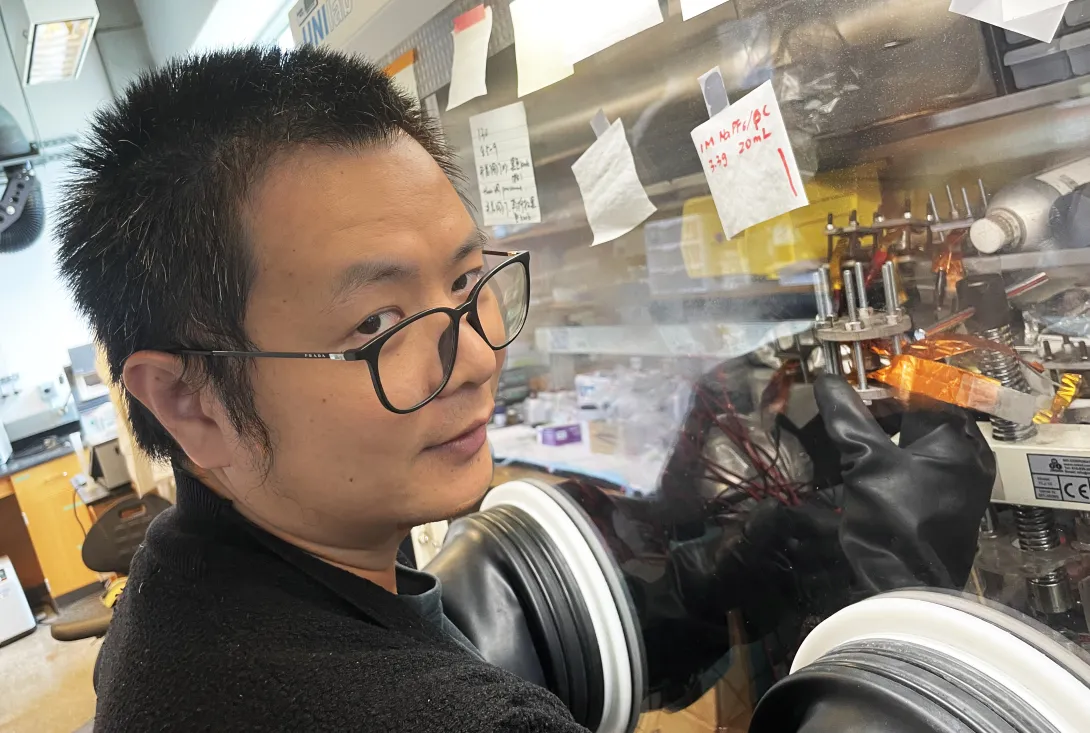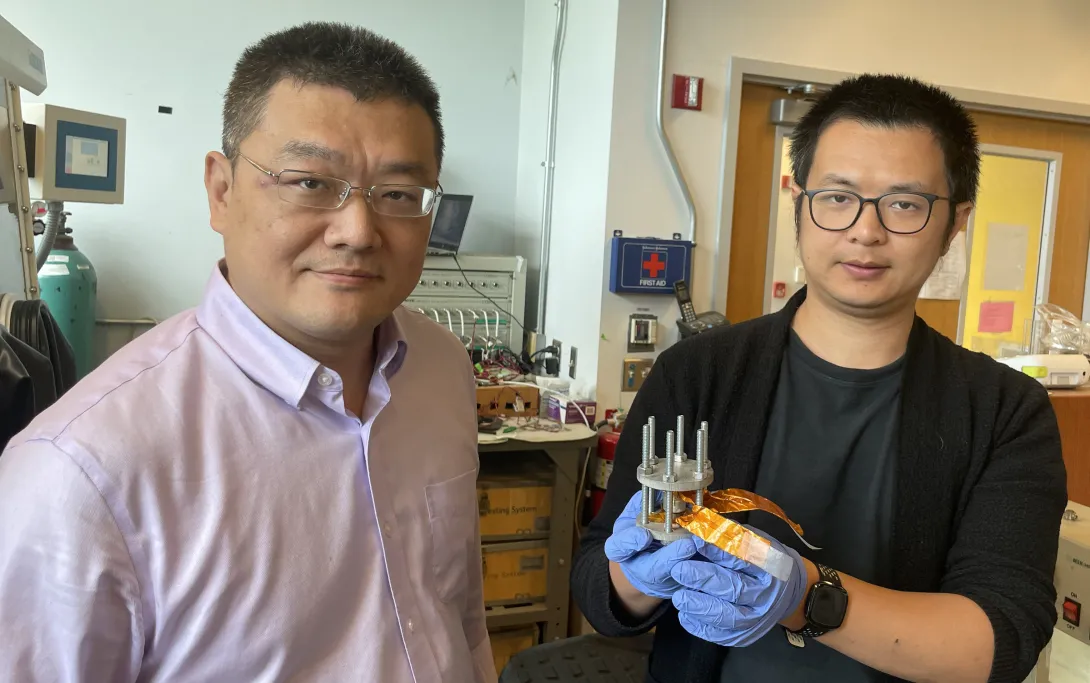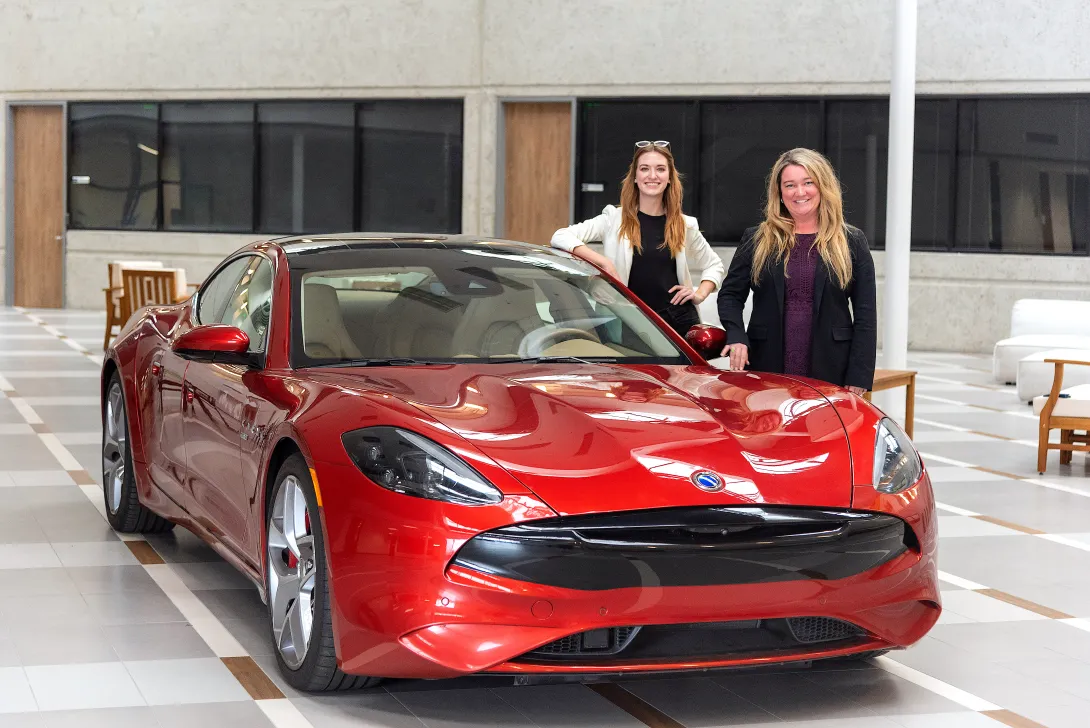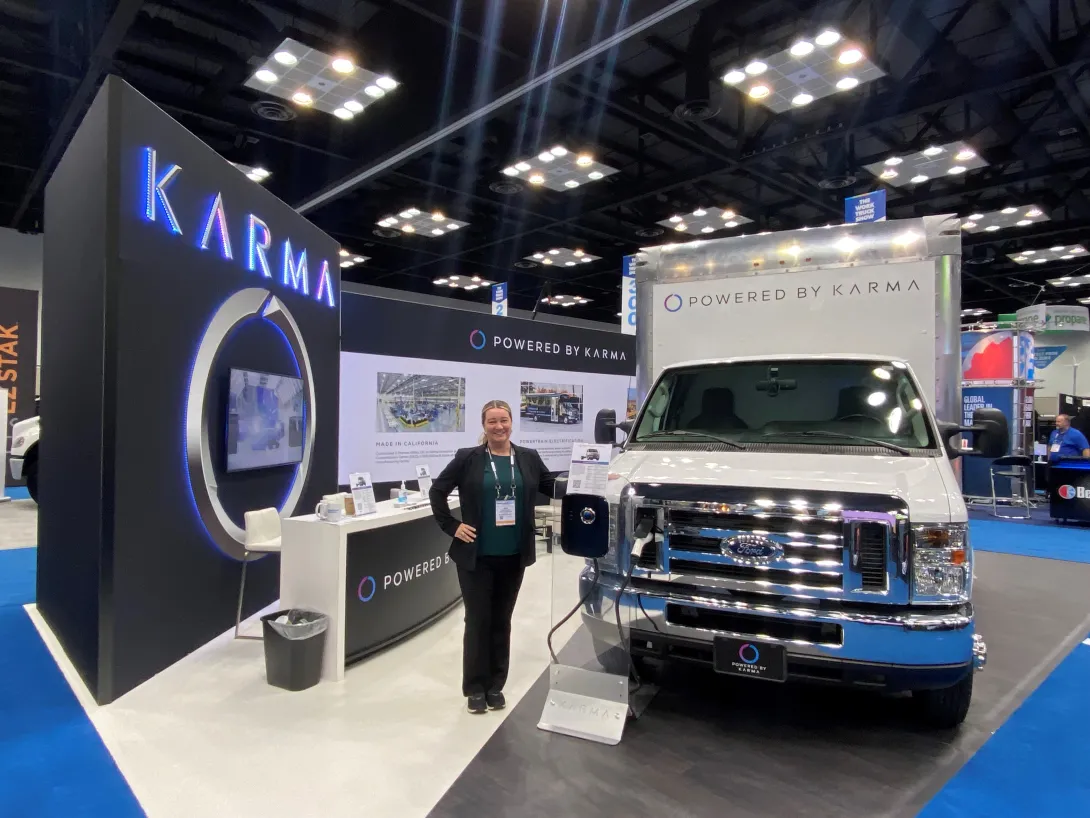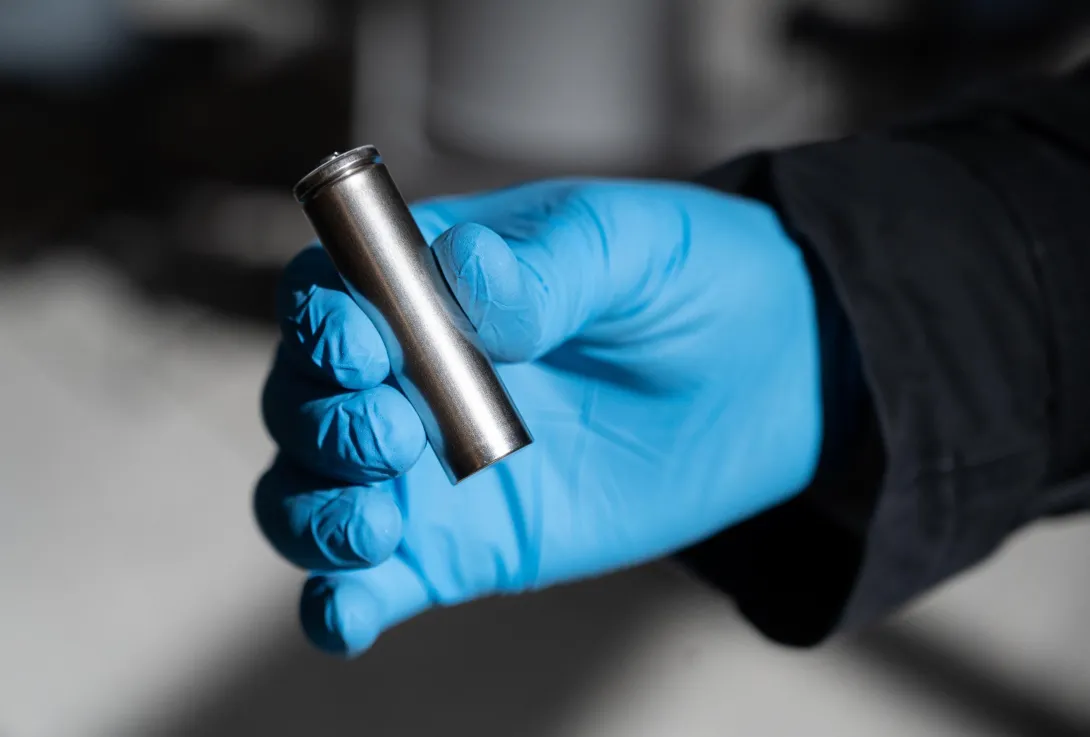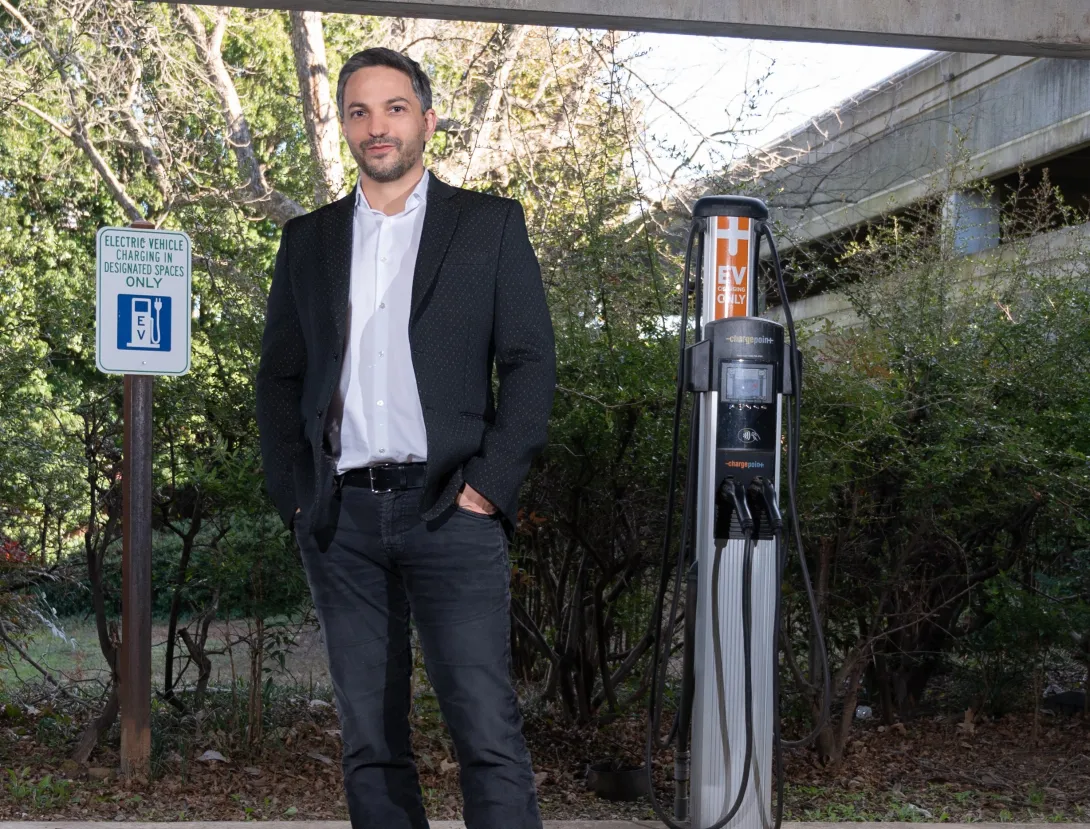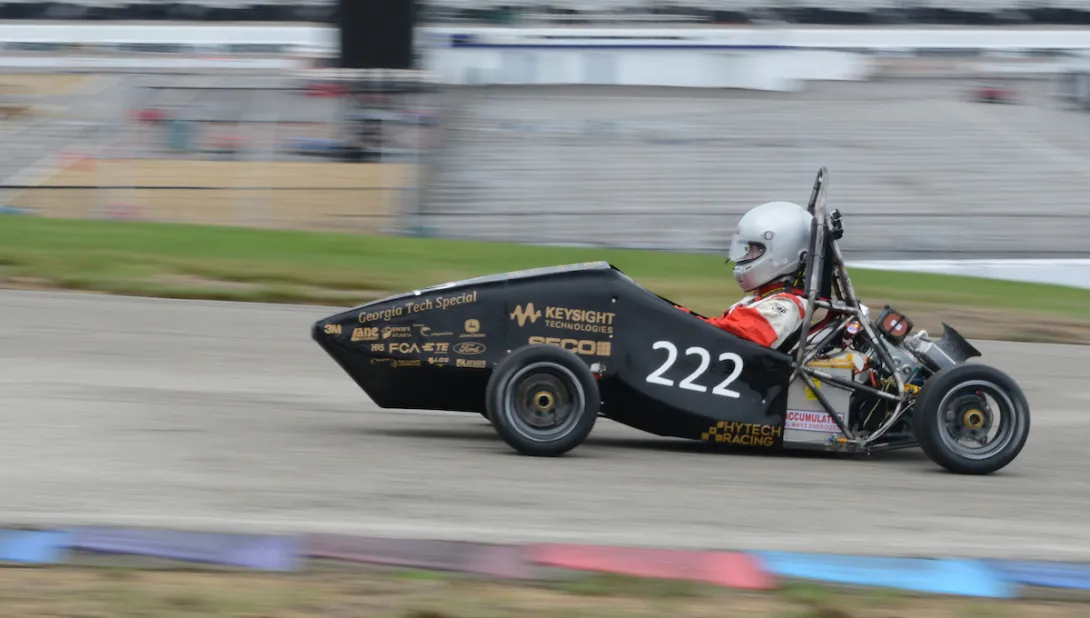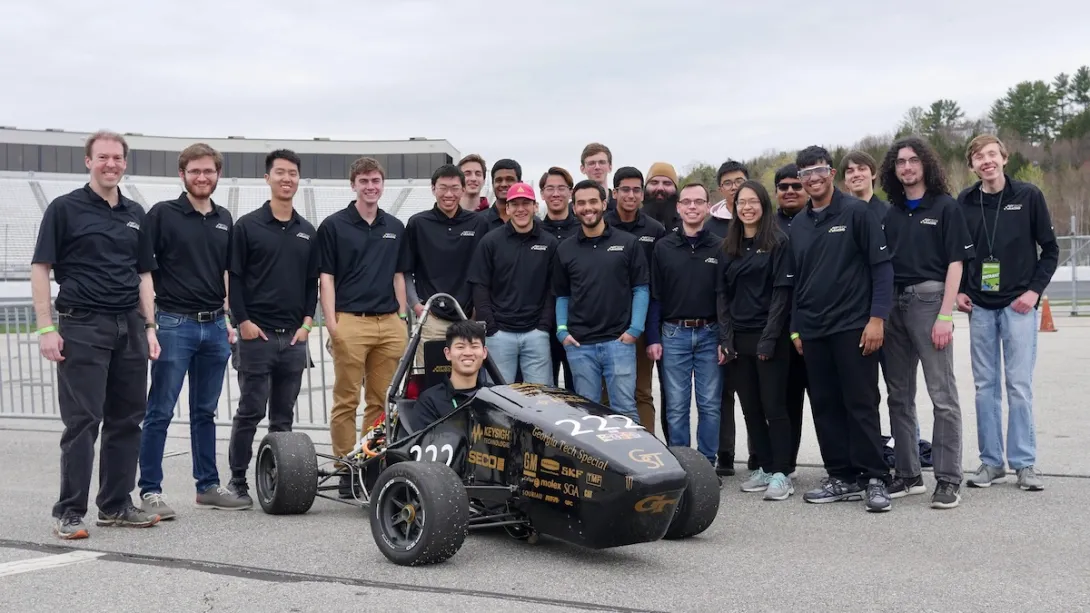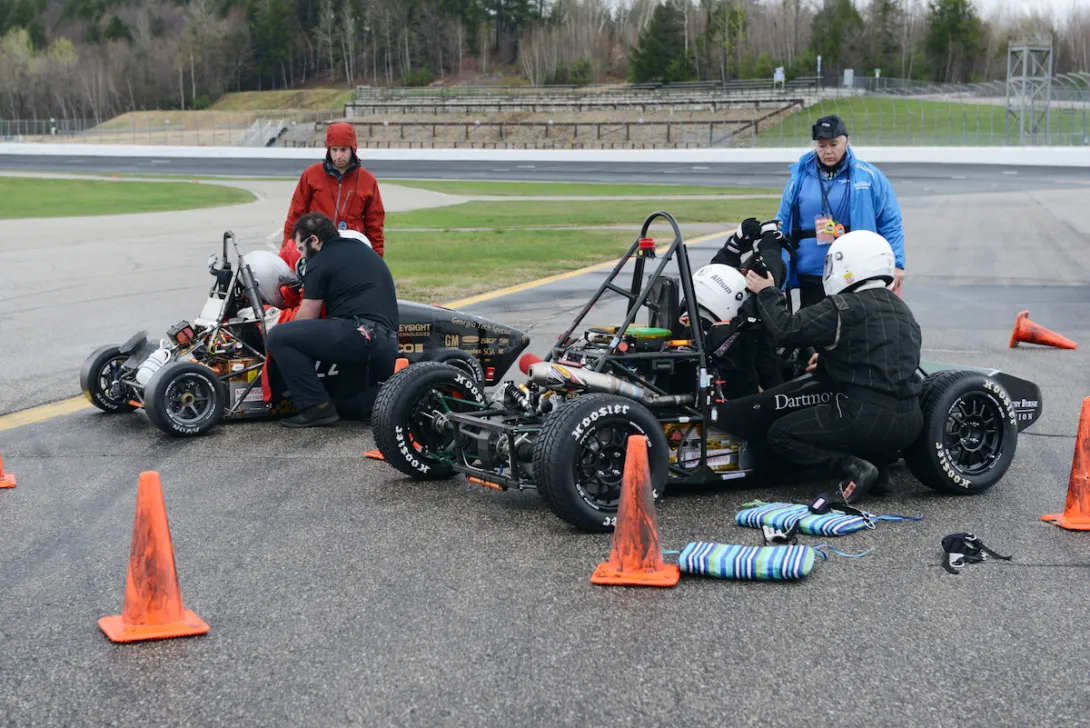Sep. 22, 2024
A multi-institutional research team led by Georgia Tech’s Hailong Chen has developed a new, low-cost cathode that could radically improve lithium-ion batteries (LIBs) — potentially transforming the electric vehicle (EV) market and large-scale energy storage systems.
“For a long time, people have been looking for a lower-cost, more sustainable alternative to existing cathode materials. I think we’ve got one,” said Chen, an associate professor with appointments in the George W. Woodruff School of Mechanical Engineering and the School of Materials Science and Engineering.
The revolutionary material, iron chloride (FeCl3), costs a mere 1-2% of typical cathode materials and canstore the same amount of electricity. Cathode materials affect capacity, energy, and efficiency, playing a major role in a battery’s performance, lifespan, and affordability.
“Our cathode can be a game-changer,” said Chen, whose team describes its work in Nature Sustainability. “It would greatly improve the EV market — and the whole lithium-ion battery market.”
First commercialized by Sony in the early 1990s, LIBs sparked an explosion in personal electronics, like smartphones and tablets. The technology eventually advanced to fuel electric vehicles, providing a reliable, rechargeable, high-density energy source. But unlike personal electronics, large-scale energy users like EVs are especially sensitive to the cost of LIBs.
Batteries are currently responsible for about 50% of an EV’s total cost, which makes these clean-energy cars more expensive than their internal combustion, greenhouse-gas-spewing cousins. The Chen team’s invention could change that.
Building a Better Battery
Compared to old-fashioned alkaline and lead-acid batteries, LIBs store more energy in a smaller package and power a device longer between charges. But LIBs contain expensive metals, including semiprecious elements like cobalt and nickel, and they have a high manufacturing cost.
So far, only four types of cathodes have been successfully commercialized for LIBs. Chen’s would be the fifth, and it would represent a big step forward in battery technology: the development of an all-solid-state LIB.
Conventional LIBs use liquid electrolytes to transport lithium ions for storing and releasing energy. They have hard limits on how much energy can be stored, and they can leak and catch fire. But all-solid-state LIBs use solid electrolytes, dramatically boosting a battery’s efficiency and reliability and making it safer and capable of holding more energy. These batteries, still in the development and testing phase, would be a considerable improvement.
As researchers and manufacturers across the planet race to make all-solid-state technology practical, Chen and his collaborators have developed an affordable and sustainable solution. With the FeCl3 cathode, a solid electrolyte, and a lithium metal anode, the cost of their whole battery system is 30-40% of current LIBs.
“This could not only make EVs much cheaper than internal combustion cars, but it provides a new and promising form of large-scale energy storage, enhancing the resilience of the electrical grid,” Chen said. “In addition, our cathode would greatly improve the sustainability and supply chain stability of the EV market.”
Solid Start to New Discovery
Chen’s interest in FeCl3 as a cathode material originated with his lab’s research into solid electrolyte materials. Starting in 2019, his lab tried to make solid-state batteries using chloride-based solid electrolyteswith traditional commercial oxide-based cathodes. It didn’t go well — the cathode and electrolyte materials didn’t get along.
The researchers thought a chloride-based cathode could provide a better pairing with the chloride electrolyte to offer better battery performance.
“We found a candidate (FeCl3) worth trying, as its crystal structure is potentially suitable for storing and transporting Li ions, and fortunately, it functioned as we expected,” said Chen.
Currently, the most popularly used cathodes in EVs are oxides and require a gigantic amount of costly nickel and cobalt, heavy elements that can be toxic and pose an environmental challenge. In contrast, the Chen team’s cathode contains only iron (Fe) and chlorine (Cl)—abundant, affordable, widely used elements found in steel and table salt.
In their initial tests, FeCl3 was found to perform as well as or better than the other, much more expensive cathodes. For example, it has a higher operational voltage than the popularly used cathode LiFePO4 (lithium iron phosphate, or LFP), which is the electrical force a battery provides when connected to a device, similar to water pressure from a garden hose.
This technology may be less than five years from commercial viability in EVs. For now, the team will continue investigating FeCl3 and related materials, according to Chen. The work was led by Chen and postdoc Zhantao Liu (the lead author of the study). Collaborators included researchers from Georgia Tech’s Woodruff School (Ting Zhu) and the School of Earth and Atmospheric Sciences (Yuanzhi Tang), as well as the Oak Ridge National Laboratory (Jue Liu) and the University of Houston (Shuo Chen).
“We want to make the materials as perfect as possible in the lab and understand the underlying functioning mechanisms,” Chen said. “But we are open to opportunities to scale up the technology and push it toward commercial applications.”
CITATION: Zhantao Liu, Jue Liu, Simin Zhao, Sangni Xun, Paul Byaruhanga, Shuo Chen, Yuanzhi Tang, Ting Zhu, Hailong Chen. “Low-cost iron trichloride cathode for all-solid-state lithium-ion batteries.” Nature Sustainability.
FUNDING: National Science Foundation (Grant Nos. 1706723 and 2108688)
News Contact
Mar. 23, 2023
Women make up just 24% of the automotive industry, but Georgia Tech graduates Jenn Voelker and Julia Vorpahl haven't let statistics stop them from paving their own way in a male-dominated field.
Both Voelker and Vorpahl work for Karma Automotive, a luxury electric vehicle manufacturer based in California. Beginning with their time at Tech, they've never let gender bias stop them from pursuing their passion.
"It's math," Vorpahl, a visualization and digital design modeler at Karma, said. "You either get the question right, or you get the question wrong. I think that attitude really helps when you get into a professional environment. It teaches you to have tougher skin where if you are the best for that job, you will get the job. That's what Georgia Tech instilled."
Vorpahl grew up in the industry watching her family operate what is now the oldest independently owned Mercedes-Benz dealer in metro Atlanta after her grandfather, an engine designer for the German automaker, came to America and opened the shop in 1967. She arrived at Georgia Tech unsure if she'd follow in her family's footsteps, but ultimately, she landed an internship at Daimler, the nation's largest commercial vehicle manufacturer.
While other interns came in with a background in automotive design, Vorpahl’s willingness to learn and tireless work ethic landed her a full-time job as the only woman in the company's design studio.
During her three years at Daimler before accepting her position at Karma in 2022, she'd occasionally make the drive from Portland, Oregon, back to Georgia. Along the way, she crossed paths with truckers, who often expressed surprise that Vorpahl was among those behind the scenes designing their rigs. She often heard questions like “Why do you work there?” or “How did you end up there?”
And her response was simple. "Women like cars, too.”
That rang true through Voelker's childhood as well. When the senior director of program management for Karma arrived in Atlanta for her first year at Georgia Tech, she knew she'd found a place that could help her turn an aptitude for math and science, and a fervor for cars, into a career.
"Best move I ever made," Voelker said on her decision to enroll at Tech, although it wasn't just the Institute's stellar reputation that lured her from her home state of New Hampshire. "I visited campus in February. There was 6 feet of snow on the ground and then I came to Atlanta, and the flowers were blooming."
After changing her major from mechanical engineering to industrial design, Voelker got her foot in the door through an internship with Masterack, a commercial cargo vehicle equipment manufacturer based in Atlanta. She attended Tech at a time when women made up around 27% of the undergraduate population, so when she entered the workforce, she wasn't fazed. "It never bothered me. I have always felt like I fit right in, especially when it's the right school, the right class, or the right company where everybody appreciates learning from each other and working together towards a common goal," she said.
In fact, her experience on North Avenue taught her to always keep learning and never give up, a piece of advice she now passes along to other women entering the industry.
"Don’t be afraid to give your opinion in meetings, speak up and use all of the knowledge that you've learned over the years toward whatever project you're working on," said Voelker, who worked her way up the ladder at Masterack for 18 years before seeking a new challenge at Karma. “That's one thing that I haven't backed down on. If I have a strong opinion about something, I have no fear of saying it.”
Vorpahl and Voelker each commended Karma for their dedication to promoting hard-working women and a culture that fosters diversity — a principle that Vorpahl especially values after completing two study abroad programs at the University of Singapore and the University of Strathclyde.
“One of the biggest advantages was seeing how people from different countries approach design and how different schools approach design. You don’t want a bunch of people who all think exactly the same way. Otherwise, we’d all be driving around in the exact same vehicle,” she said.
Leading Karma’s commercial vehicle product line, Voelker noted that she has continued to see more women in leadership positions and at industry conferences, and she hopes that momentum carries over to the next generation. Highlighting the importance of igniting both young girls’ and boys' interest in STEM, Voelker recently spoke to a local second grade class to share her experiences.
"I've been really fortunate to have had some great mentors over my career, so I love to pay it forward to the younger generation," she said. "They were so excited, and I hope that stays with them and excites them to learn more about engineering."
In addition to providing an example to young women of how to succeed in a competitive industry, Vorpahl also hopes to share the technical aspects of what she's learned in the field with her alma mater and offer future graduates a roadmap to a career in automotive design.
"The students would thrive in this industry because it is so nitpicky, and Tech minds would just love it," she said. "There's not really a direct path from the Georgia Tech studios into car studios, so I'm hoping that I can show them that path."
Voelker and Vorpahl are bonded by their employer and their alma mater, but it’s their shared passion for seeing their hard work hit the pavement that continues to drive them.
Dec. 13, 2022
In the decade since Professor Gleb Yushin’s battery materials startup participated in Georgia Tech’s Advanced Technology Development Center, investments in the company have rolled in — along with the first customers.
Now the U.S. Department of Energy (DOE) is getting on board with Yushin’s Georgia Tech startup as part of federal efforts to reinvigorate tech manufacturing in the United States.
DOE awarded Sila Nanotechnologies $100 million this fall to support the company’s new factory in Moses Lake, Washington, and help Sila hire and train up to 300 workers for the facility. It was one of 21 projects funded in domestic battery materials processing and manufacturing.
“It’s our mission to help move America away from being energy dependent and become a leader in the energy transformation,” said Yushin, the company’s chief technology officer and a faculty member in the Georgia Tech School of Materials Science and Engineering. “With this funding, Sila will deliver proven, clean energy technology and world-scale manufacturing to revitalize the industry and gain independence.”
Birthed from Yushin’s research on lithium-ion batteries, Sila manufactures next-generation materials and a silicon anode technology that boosts battery energy density by 20%. The silicon anodes are a drop-in replacement for graphite anodes in lithium-ion batteries. The new facility is projected to produce enough capacity to power 200,000 electric vehicles by 2026. Sila has inked a deal with Mercedes-Benz to use the company’s technology, starting with G-Class vehicles.
News Contact
Joshua Stewart
College of Engineering
Mar. 08, 2021
A new fabrication technique could allow solid-state automotive lithium-ion batteries to adopt nonflammable ceramic electrolytes using the same production processes as in batteries made with conventional liquid electrolytes.
The melt-infiltration technology developed by materials science researchers at the Georgia Institute of Technology uses electrolyte materials that can be infiltrated into porous yet densely packed, thermally stable electrodes. The one-step process produces high-density composites based on pressure-less, capillary-driven infiltration of a molten solid electrolyte into porous bodies, including multilayered electrode-separator stacks.
“While the melting point of traditional solid state electrolytes can range from 700 degrees Celsius to over 1,000 degrees Celsius, we operate at a much lower temperature range, depending on the electrolyte composition, roughly from 200 to 300 degrees Celsius,” explained Gleb Yushin, a professor in the School of Materials Science and Engineering at Georgia Tech. “At these lower temperatures, fabrication is much faster and easier. Materials at low temperatures don’t react. The standard electrode assemblies, including the polymer binder or glue, can be stable in these conditions.”
The new technique, to be reported March 8 in the journal Nature Materials, could allow large automotive Li-ion batteries to be made safer with 100% solid-state nonflammable ceramic rather than liquid electrolytes using the same manufacturing processes of conventional liquid electrolyte battery production. The patent-pending manufacturing technology mimics low-cost fabrication of commercial Li-ion cells with liquid electrolytes, but instead uses solid state electrolytes with low melting points that are melted and infiltrated into dense electrodes. As a result, high-quality multi-layered cells of any size or shape could be rapidly manufactured at scale using proven tools and processes developed and optimized over the last 30 years for Li-ion.
“Melt-infiltration technology is the key advance. The cycle life and stability of Li-ion batteries depend strongly on the operating conditions, particularly temperature,” Georgia Tech graduate student Yiran Xiao explained. “If batteries are overheated for a prolonged period, they commonly begin to degrade prematurely, and overheated batteries may catch on fire. That has prompted nearly all electric vehicles (EV) to include sophisticated and rather expensive cooling systems.” In contrast, solid-state batteries may only require heaters, which are significantly less expensive than cooling systems.
Yushin and Xiao are encouraged by the potential of this manufacturing process to enable battery makers to produce lighter, safer, and more energy-dense batteries.
“The developed melt-infiltration technology is compatible with a broad range of material chemistries, including so-called conversion-type electrodes. Such materials have been demonstrated to increase automotive cell energy density by over 20% now and by more than 100% in the future,” said co-author and Georgia Tech research scientist Kostiantyn Turcheniuk, noting that higher density cells support longer driving ranges. The cells need high-capacity electrodes for that performance leap.
Georgia Tech’s technique is not yet commercially ready, but Yushin predicts that if a significant portion of the future EV market embraces solid-state batteries, “This would probably be the only way to go,” since it will allow manufacturers to use their existing production facilities and infrastructure.
“That’s why we focused on this project – it was one of the most commercially viable areas of innovation for our lab to pursue,” he said.
Battery cell prices hit $100 per kilowatt hour for the first time in 2020. According to Yushin, they will need to drop below $70 per kilowatt hour before the consumer EV market can fully open. Battery innovation is critical to that occurring.
The Materials Science lab team currently is focused on developing other electrolytes that will have lower melting points and higher conductivities using the same technique proven in the lab.
Yushin envisions this research team’s manufacturing advance opening the floodgates to more innovation in this area.
“So many incredibly smart scientists are focused on solving very challenging scientific problems, while completely ignoring economic and technical practicality. They are studying and optimizing very high-temperature electrolytes that are not only dramatically more expensive to use in cells but are also up to five times heavier compared with liquid electrolytes,” he explained. “My goal is to push the research community to look outside that chemical box.”
In addition to Yushin, Xiao and Turcheniuk, co-authors included Aashray Narla, Ah-Young Song, Alexandre Magasinski, Ayush Jain, Sheirley Huang, and Haewon Lee from Georgia Tech, and Xiaolei Re from both Georgia Tech and Chongqing Technology and Business University in China.
This work was mostly supported by Sila Nanotechnologies Inc., a Georgia Tech startup, with characterization performed at the Materials Characterization Center at Georgia Tech. Any opinions, findings, and conclusions or recommendations expressed in this material are those of the authors and do not necessarily reflect the views of the sponsoring organization.
Gleb Yushin is co-founder, CTO, and a stockholder of Sila. Yushin is entitled to royalties derived from Sila’s sale of products related to the research described in this paper. This study could affect his personal financial status. The terms of this arrangement have been reviewed and approved by Georgia Tech in accordance with its conflict of interest policies.
CITATION: Y. Xiao, et al., “Electrolyte Melt-Infiltration for Scalable Manufacturing of Inorganic All-Solid-State Lithium-Ion Batteries.” (Nature Materials, 2021) https://dx.doi.org/10.1038/s41563-021-00943-2.
News Contact
Anne Wainscott-Sargent
Research News
(404-435-5784)
Mar. 04, 2021
It’s hard to believe that before coming to Georgia Tech, Gleb Yushin had never worked with batteries. Nearly 15 years later, his materials research is enabling space travel, revolutionizing the automotive industry, and contributing to clean, sustainable energy systems.
“When I arrived at Tech, I thought that innovations in batteries were long overdue,” recalled Yushin, professor in the School of Materials Science and Engineering. “It may be hard to believe now, with so much excitement in electric vehicles and the recent Nobel Prize given to the lithium-ion battery inventors, but at that time, lithium-ion batteries were considered to be a ‘mature’ technology.”
Yushin’s passion for battery research led him to co-found Sila Nanotechnologies, Inc. in 2011, where he now serves as chief technology officer. Sila Nano just received a Series F funding round that boosted its valuation to over $3.3 billion. The latest investment will enable the company to evolve the electric vehicle batteries it has come to be known for and also begin introducing its high-energy battery technology into consumer devices, like fitness trackers and wireless earbuds.
For Yushin and his company, this is a watershed moment, as it looks to add 100 new positions to its existing 200 employee base and open a battery materials buildout factory in the U.S. by 2024.
But this also marks a significant moment for Georgia Tech. Sila Nano’s success can serve as inspiration to faculty, research scientists, and students looking to commercialize their own research.
“The more successful entrepreneurs we have at Tech, the more they can teach others to do it right,” Yushin said. “Furthermore, successful startups generate recognition and publicity for their universities, helping to attract ambitious and talented students from around the world.”
Companies like Sila Nano – and others that have been spun out of incubators like ATDC and CREATE-X – are playing a large role in building the commercialization ecosystem at Georgia Tech.
“The success of Sila Nano — not just in its latest valuation, but also the impact it’s having on the U.S. economy and clean energy initiatives — is very exciting for Tech,” said Raghupathy Sivakumar, interim chief commercialization officer, co-founder of CREATE-X, and engineering professor at Georgia Tech. “Bringing together commercialization and technology transfer activities with a goal of moving more intellectual property out into the marketplace greatly expands Georgia Tech’s impact on the world. We couldn’t be prouder of Gleb and the company he has built with his co-founders.”
From Research to Commercialization
At Tech, research doesn’t happen in a vacuum. Engineers and scientists like Yushin actively look for ways to translate technology advancements into practical applications. Case in point: Sila Nano alone has licensed 14 different patents from the Georgia Tech Research Corporation.
“Most large companies have trouble identifying and commercializing revolutionary technologies that now commonly originate at universities or national labs rather than in industrial laboratories,” Yushin said. “If we want to have a strong, innovation-driven economy, commercializing university research is a must.”
The lab-to-market pipeline at Tech continues to grow, with a growing list of successful companies — Brain Rain Solutions, Carbice, Zyrobotics and Sanguina, to name a few recent examples. Yushin said forming a proper ecosystem is the key to establishing the culture of thriving innovation at Tech and in Atlanta.
“The more notably successful startups that originate from Tech, the higher the chance that venture capital firms and aspiring entrepreneurs will be looking to us for breakthrough technology and research,” Yushin said. “Also, many students come to Tech with a goal of starting their own company because they see what we are doing.”
So, what’s next for Sila Nano? Yushin plans to continue to improve and dramatically expand production of revolutionary materials for next-generation batteries that will power electric cars, trucks and buses and eventually hybrid-electric ships, planes and autonomous flying taxis. They will also become part of the renewable energy grid, he said.
As Yushin keeps advancing the storage power of batteries so, too, will Tech continue tapping the power of research and innovation to develop market-ready ideas that improve the human condition. The example of Sila Nano demonstrates the powerful potential.
“It is incredibly exciting to contribute to building a clean, energy-sustainable future rather than waiting for it to happen,” Yushin said. “At Sila, we have showcased the major impact of materials science engineering on the future of transportation and the clean energy economy. As a Tech scientist and engineer, that makes me very proud.”
News Contact
Georgia Parmelee, Communications Program Manager, College of Engineering, Georgia Tech
Jun. 24, 2019
For the second year in a row, HyTech Racing has brought the first-place trophy from Formula Hybrid back to Georgia Tech. The team outperformed its previous record, running in the Acceleration and Autocross events for the first time at this competition and placing first in the Autocross event with a 44.092 second run. With their 368 lb vehicle, the lightest at the competition, HyTech was the only team to finish the 44 km Endurance course this year, beating the University of Vermont’s previous 01:25:15 record with a 01:15:56 track time and becoming the second electric team to ever complete the 44 km Endurance course in Formula Hybrid history.
HyTech Racing is Georgia Tech’s Formula Student electric vehicle engineering team. On this team, students from a wide array of disciplines, from Mechanical Engineering to Aerospace Engineering, Electrical Engineering, and Computer Science, work together year-round to design fully electric race cars. “The work that is happening on teams like HyTech is an important part of the experiential learning here at Georgia Tech,” said Dr. Samuel Graham, Eugene C. Gwaltney, Jr. Professor and Chair of Georgia Tech’s Woodruff School of Mechanical Engineering. Working on this multidisciplinary team, students learn to work effectively with deadlines and budgets, solving real-world engineering and business problems before graduating into the workforce with valuable experience applicable to their industry.
Closing out its 13th competition year, Formula Hybrid brings together students from around the world each May at the New Hampshire Motor Speedway to identify the best-engineered and best-performing electric and hybrid open-wheel Formula racing-style vehicles conforming to the competition rules. Before testing the dynamic performance of the vehicle, each team must pass through a rigorous scrutineering process. Engineers, many from the automotive industry, inspect each vehicle to ensure that it meets competition rules and can be safely operated.
The competition also measures the engineering behind each team’s vehicle. Georgia Tech’s team defended the design methodologies behind its new vehicle, where significant engineering effort was put into reducing the weight of components compared to the team’s vehicles from previous years. “There's an old adage in racing that goes 'more power makes you faster in the straights, losing weight makes you faster everywhere',” said Sam Gilmer, Chief Engineer of HyTech Racing. “Being light means your tires are more efficient and you have less momentum and accelerate more quickly.” After building a 413 lb vehicle last year, the team worked towards a goal of building a 380 lb vehicle in 2019, exceeding this goal with an official vehicle weight of 368 lb.
While the team won the design portion of the competition, it also defended its project management strategy, placing second in the category. “Working with over 60 students to engineer such a complex vehicle takes a significant amount of planning and oversight,” said Nathan Cheek, Team President. “We focused this year on making a very lightweight and tightly packaged vehicle, so facilitating communication between subteams was critical for ensuring that everything would fit together and work together.”
Vehicle performance is measured through a number of dynamic events. First, each vehicle’s acceleration capabilities are measured at the 75 meter Acceleration track. Second, vehicle handling is put to the test on the Autocross course. Finally, the ability of each vehicle to run reliably is tested through the 44 km Endurance event. HyTech placed second in the Acceleration event with a 5.28 second time and won the Autocross event with a 44.092 second run. On the Endurance course, the team beat out Princeton University, The University of Vermont, and Tufts University, completing more than twice the number of laps than the second-place team. As the only team to finish all 44 km of the Endurance event this year, Georgia Tech’s team set a new track time record of 01:15:56, beating the previous record of 01:25:15 held by The University of Vermont and cementing themselves as the second fully electric team to ever finish the 44 km course.
HyTech Racing finished the Formula Hybrid competition with a 262 point lead, taking home 899 points out of 1,000. “Next year we are going to focus on making the car even lighter and better-performing using data we gathered from this year's success,” said Yvonne Yeh, incoming Team President for the 2020 school year. The team plans to work iteratively, building a new vehicle with updates only to the systems that will most improve the car’s performance. “It’s important to update these vehicles methodically year-to-year,” said Nathan Cheek. “Making calculated engineering updates to specific vehicle subsystems is the best way to ensure we have plenty of testing time on our new vehicle before taking it to a competition.”
News Contact
Nathan Cheek
ncheek@gatech.edu
